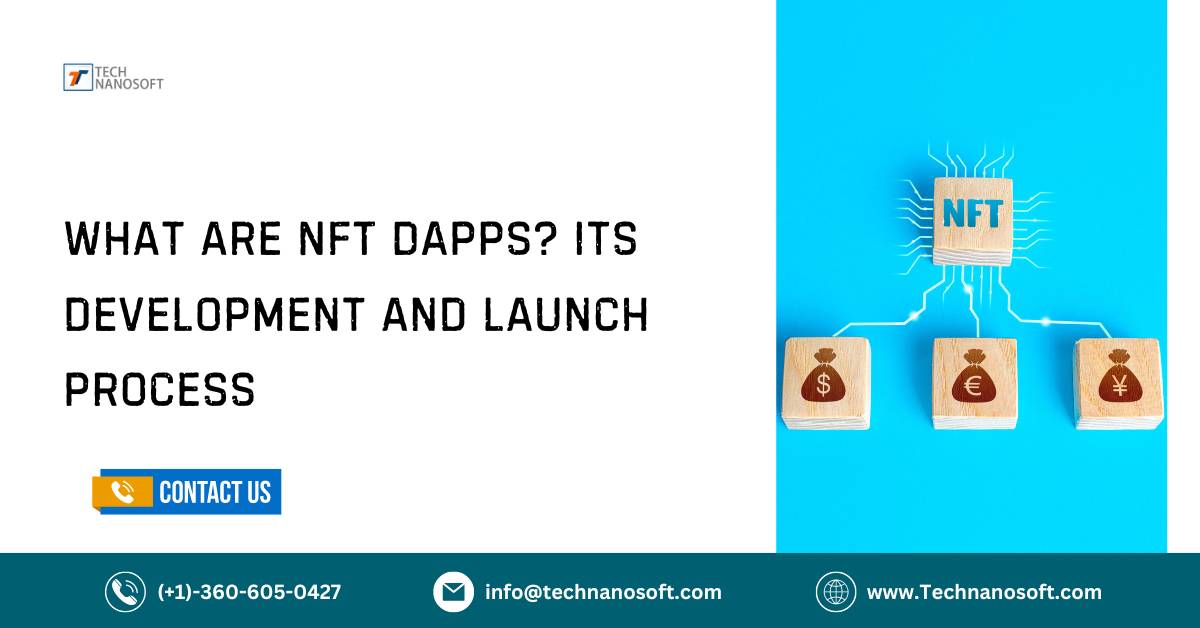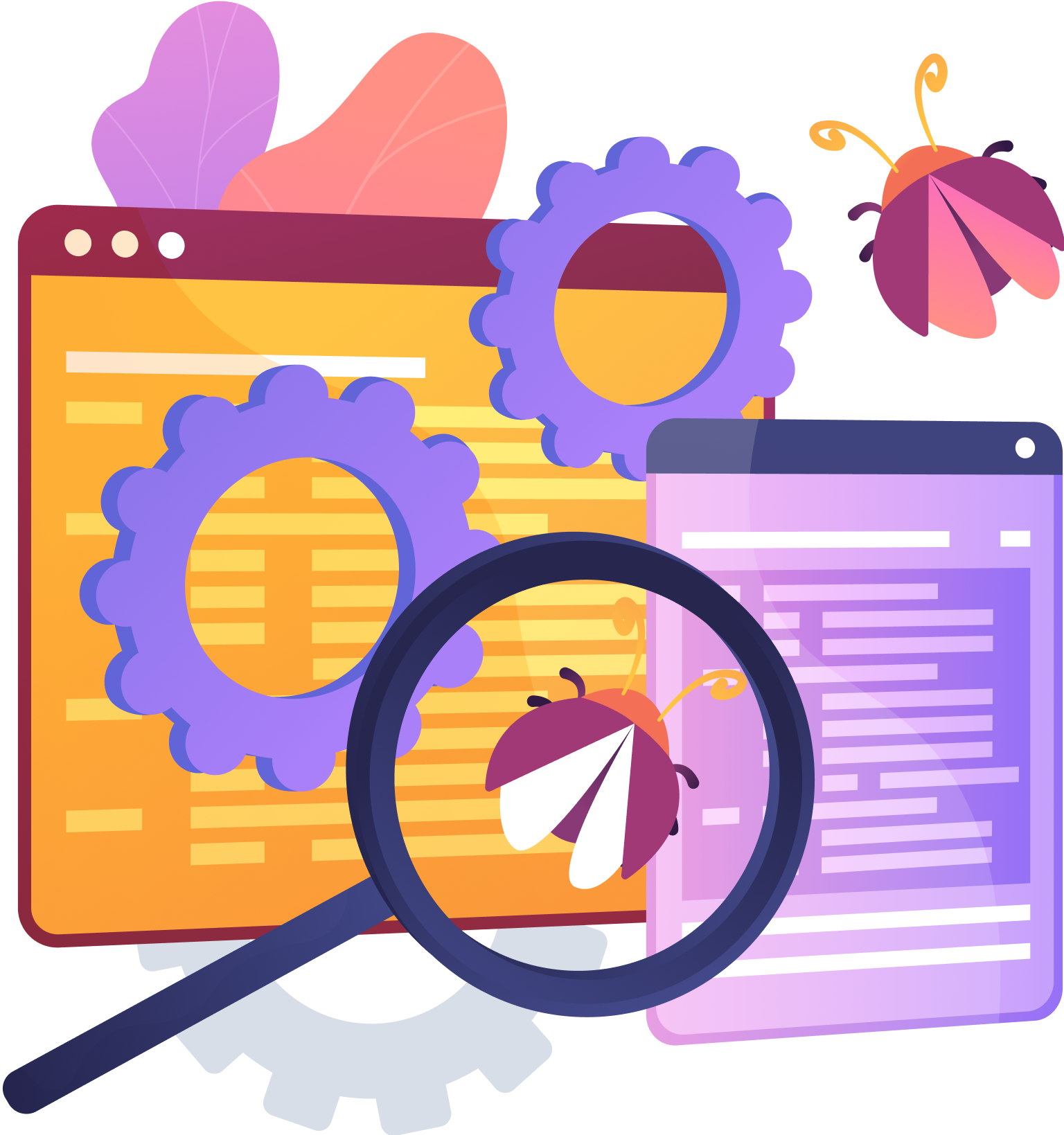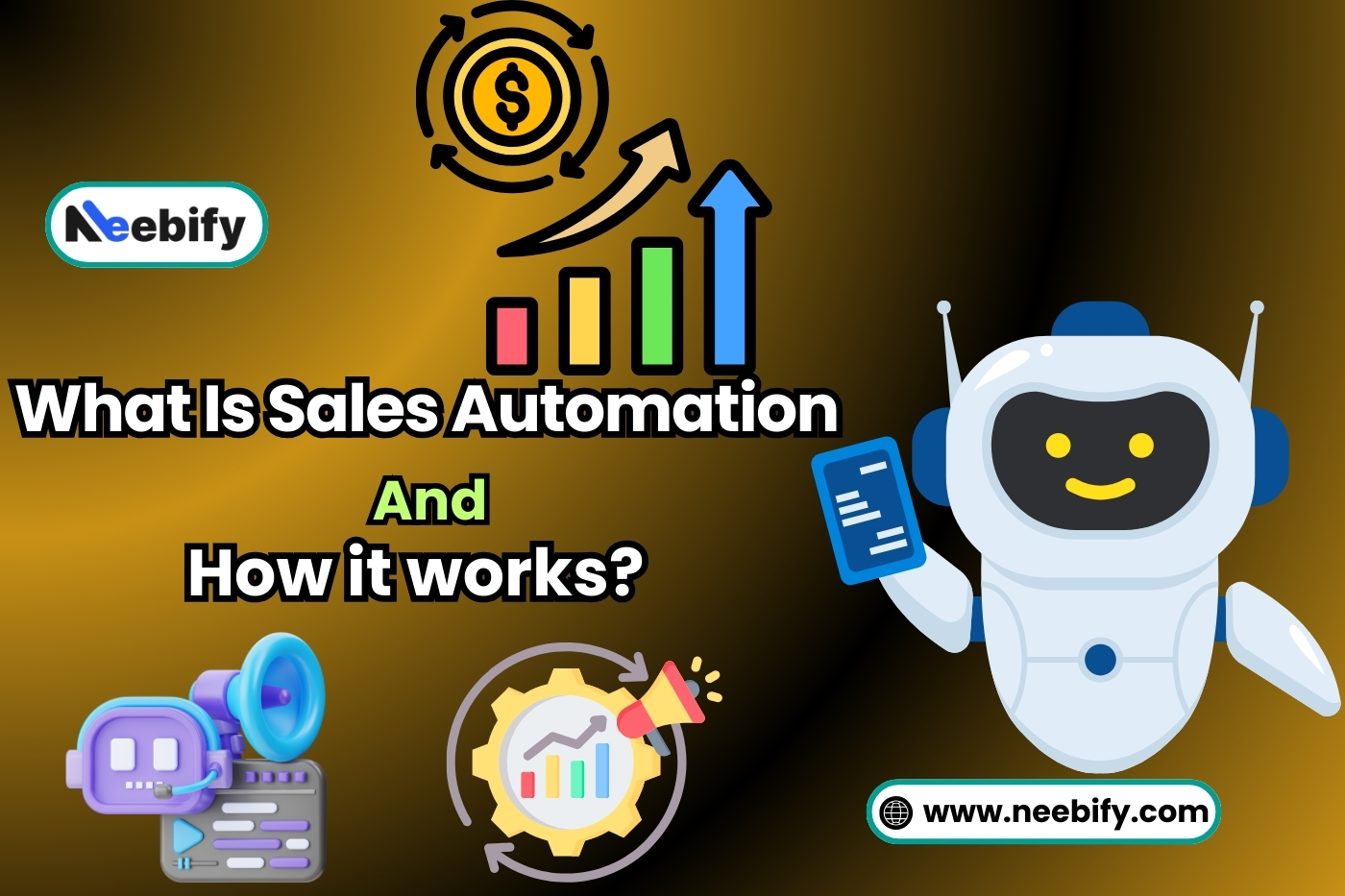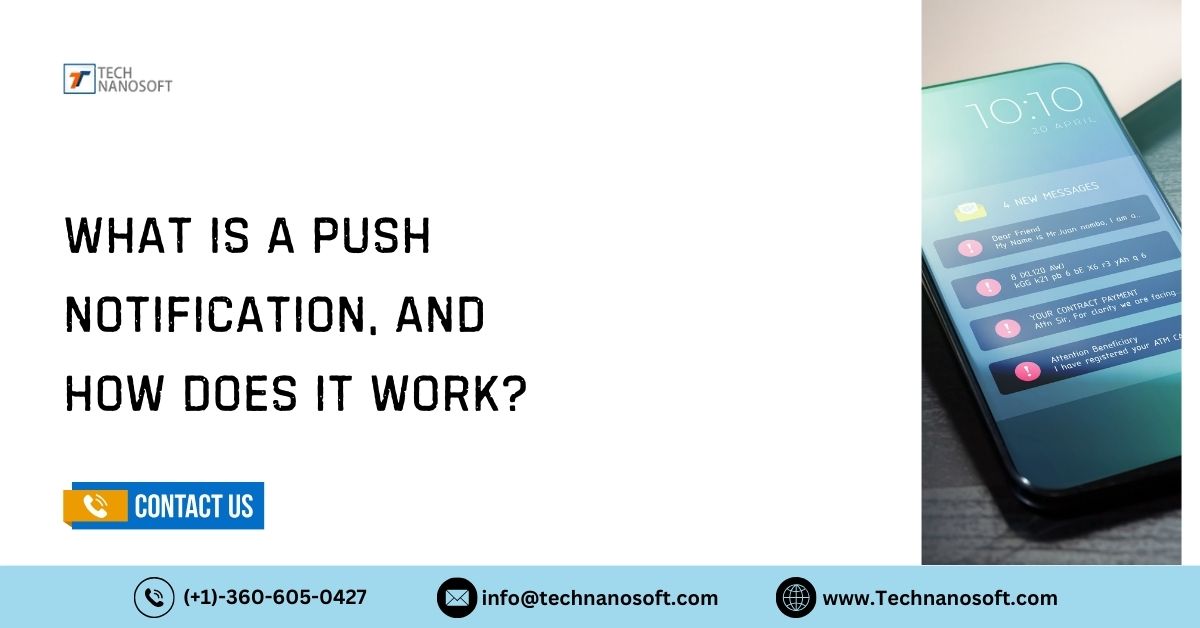What are NFT DApps? its development and launch process

Non-fungible tokens (NFTs) and decentralized applications (DApps) are two emerging blockchain technologies that are transforming digital ecosystems independently. Unique digital assets known as NFTs which signify authenticity or ownership have flourished in industries such as gaming, collectables, and the arts. DApps, or decentralized apps, on the other hand, offer improved security and transparency across all sectors.
Their coming together signifies a hub of innovation where digital assets integrated into decentralized networks as active components. This synergy transforms how we think about ownership, transactions, and digital experiences while unleashing a flood of creativity and disruption that offers fresh answers.
What are NFT DApps?
Blockchain technology's independent nature lets them make apps that work without any middlemen or central control. These apps not use traditional centralized servers. Instead, they work with a group of computers known as nodes.
DApps leverage cryptographic protocols and smart contracts to provide enhanced security, transparency, and resistance to censorship. They start a new era of creativity and user freedom because they change the way standard, centralized systems work. They can be used for many things, like banking, gaming, supply chain management, and more.
How Do NFT DApps Revolutionize Digital Ownership?
By bringing previously unheard-of levels of openness, security, and interoperability, NFT DApps transform digital ownership. NFT DApps use blockchain technology to provide unchangeable ownership records, removing the possibility of fraud or counterfeiting. These DApps also enable verifiable scarcity, fractional ownership, and royalty mechanisms, giving artists and users more control over their digital goods. NFT DApps promote inclusivity and creativity in the digital economy by democratizing access to digital assets through the use of decentralized networks.
Benefits of NFT DApps
Immutable Ownership
NFT DApps use blockchain technology's immutable records to alter who owns what in the digital world. Each NFT has a unique cryptographic signature that acts like a digital fingerprint to show where it came from and that it is real.
Proof of ownership that can't be changed keeps digital assets safe and increases their value over time. This is true for both rare works of art and virtual properties. This takes away the worry of copying or hacking and builds trust in the NFT market, which is growing.
Interoperability
At the heart of NFT DApps is the promise of connectivity, which lets digital assets be easily moved between different platforms and environments. By defining protocols and supporting open standards, NFT DApps make it possible for NFTs to move without any problems. The compatibility of NFTs makes them more useful, and it also encourages creativity by letting developers use their adaptability to make new experiences and apps that help the digital economy grow.
Decentralization
NFT DApps, which free consumers and producers from the constraints imposed by central intermediaries, are the best example of decentralization. Using blockchain technology and smart contracts, NFT DApps give people direct control over their digital assets. This gets rid of the need for central authorities or markets.
Everyone can get to it more easily, and the decentralized design supports an environment that is more fair and open. Users have more control over their digital portfolios, and artists keep the rights to their work. NFT DApps work because they are decentralized, which changes who owns what and where digital trade is going.
Global Availability
NFT DApps give producers and collectors unrivaled access to the global digital economy. NFT DApps provide a fair platform where individuals from various backgrounds can engage in economic activity and artistic expression without fear of discrimination or exclusion by utilizing blockchain's decentralized architecture.
People from all over the world can join the NFT group and share their ideas and skills. This also pushes people from different cultures to work together and talk to each other, which leads to growth and new ideas. The digital world is more alive and linked. These worlds are full of opportunities for everyone because they value and accept differences.
Monetization Opportunities
NFT DApps give creators a lot of ways to make money, so they can tokenize and make money right away from their digital works. NFT DApps can help artists, musicians, and people who build virtual homes find new ways to make money and connect with friends and customers around the world.
If creators use smart contracts to enforce fee agreements, they can be sure that earnings are shared fairly and openly every time their NFTs are traded or resold. In addition to enabling creators to follow their passions, this democratization of monetization fosters creativity and innovation, which propels the NFT ecosystem's ongoing expansion.
READ ALSO- How Do Application Virtual Switch and Virtualization Work?
Types of NFT DApp
NFT Marketplaces
NFT Marketplaces are bustling online places where creators and buyers swap unique digital items called NFTs. These sites make it easy to browse, buy, and sell NFTs like virtual real estate, digital art, and collectibles. They're exciting spaces where users can explore, shop, and invest in digital creations confidently. With clear transaction records and strong security, NFT marketplaces encourage innovation and growth in the decentralized economy.
Art and Collectible DApps
DApps for art and collectibles are like online stores that show off a lot of digital treasures and works of art that have been turned into NFTs. The artists use these platforms to tokenize their works of art, which lets fans own and trade one-of-a-kind works of art that have been verified.
These DApps enable community participation and discovery through user-friendly interfaces and social features, creating a vibrant marketplace for digital innovation. Art & Collectible DApps offer a platform for artists to monetize their skills and fans to find one-of-a-kind treasures, ranging from rare artworks to limited edition collectables.
Gaming DApps
Gaming DApps completely change the gaming industry by adding NFTs to interesting virtual worlds where players can own, trade, and use in-game things as digital jewels. Players now have more control over their virtual goods than ever before, like land, characters, and other things. This is possible because of open-game systems.
Gaming DApps use blockchain technology to provide demonstrable scarcity and authenticity of in-game assets. It creates new opportunities for social interaction and competitiveness among players and supports thriving player-driven economies. With the help of game DApps, players may fully own their gaming experiences, from rare objects to virtual real estate.
Metaverse DApps
Using NFTs as digital assets, metaverse DApps immerse users in vast virtual worlds where they can interact, explore, and create. These immersive platforms offer countless opportunities for exploration and cooperation by obfuscating the distinction between the actual world and the virtual one.
Metaverse DApps let people make real connections in big virtual communities and choose their own digital futures, from building virtual homes to going to virtual concerts. These DApps use blockchain technology to make sure that digital assets are safely owned and can be used with other digital assets. This helps the metaverse grow into a thriving, creative, and innovative environment.
DeFi and NFT Lending DApps
People can use their non-fungible tokens (NFTs) and decentralized finance (DeFi) in new ways with DeFi and NFT Lending DApps. These apps let people rent and borrow digital assets in creative ways. These platforms let users borrow money and put up security for their NFTs without the need for traditional financial middlemen. They do this by using smart contracts to make lending safe and clear.
DeFi and NFT Lending DApps enable users to take full advantage of the value of their digital assets and participate in the rapidly developing decentralized finance ecosystem by unleashing the potential of NFTs as collateral.
Sports NFT DApps
Sports NFT DApps change the sports memorabilia business by turning great events and assets into NFTs. Fans buy and trade digital versions of their favorite players and teams. Thanks to these channels, fans can now get player cards, game highlights, limited edition memorabilia, and other material that isn't available anywhere else.
Sports NFT DApps use blockchain technology to make sure that digital sports memorabilia is authentic and one-of-a-kind. This creates new ways for fans to connect, make money, and claim ownership in the sports industry. Sports NFT DApps preserve the aura of sports in the digital sphere, from iconic moments to adored athletes.
Utility NFT DApps
A utility token that can't be traded NFTs can be used to their full potential with the help of DApps, which give them useful apps and services that aren't just valuable. These cutting-edge platforms get their power from NFT technology. They offer many services, such as digital ownership papers, identity verification, ticketing systems, and tracking of the supply chain.
Usefulness Using blockchain's immutability and openness, NFT DApps offer safe and effective solutions to real-world problems. This raises the value and usefulness of NFTs in many ways. of sectors. Utility NFT DApps open the door to a more decentralized and effective future by optimizing logistics and authenticating transactions.
DApps For Virtual Real Estate
Virtual real estate DApps change the way people think about property ownership in the digital age by letting people buy, sell, and build on virtual land and properties in realistic virtual worlds. These virtual-world platforms work like real estate markets and give users a lot of artistic and financial choices.
Virtual Real Estate DApps make ownership and scarcity more real by tokenizing virtual properties as NFTs. This lets users build and sell virtual communities and experiences. Virtual real estate DApps make it easier to be creative and social online by letting you do things like build virtual towns and host virtual events.
Steps To Create and Launch An NFT DApp
Explain The Idea
Start by carrying out in-depth market research to determine the level of demand in the niche you have selected for NFTs. Establish a distinct value proposition and list the precise use cases that your NFT DApp will take care of. To stand out from the competition, take into account elements like digital art, collectables, gaming assets, or tokenization of real-world assets.
Select The Blockchain
Examine several blockchain systems' scalability, security, and ecosystem support to determine which is best for your NFT DApp. Take into account elements like community involvement, development tools, network congestion, and transaction fees. Examine new blockchain products designed specifically for NFTs, including layer 2 scaling solutions or dedicated NFT platforms.
Configure The Environment for Development
Set up required libraries, frameworks, and tools to create a seamless development environment. To efficiently design smart contracts, become familiar with blockchain programming languages such as Cadence for Flow or Solidity for Ethereum. For safe, certified smart contract development, utilize frameworks for development such as OpenZeppelin.
Create Intelligent Contracts
Create strong, smart contracts that specify the policies and procedures controlling your NFT DApp. Take into account elements like metadata storage, token standards (ERC-721, ERC-1155), royalties, and secondary market characteristics. Adopt best practices for security, such as input validation, access control, and defence against overflow and reentrancy issues.
Integrate a Wallet
Easily incorporate wallets for cryptocurrencies into your NFT DApp to give users safe access to their virtual assets. Make sure that wallet interactions are compatible with widely used wallet providers and standards such as Ethereum's Web3.js or EIP-1193. Put permission and authentication systems in place for your wallet to protect user money and private information.
Implement Minting Functionality
Provide user-friendly minting interfaces so that users can easily generate and personalize their NFTs. Give users the ability to upload media files, customize royalty structures, and specify metadata elements. Employing batch minting and off-chain metadata storage when appropriate, use gas-efficient minting procedures to reduce transaction costs and enhance user experience.
Test Thoroughly and Deploy
Make sure your NFT DApp is secure and functioning by doing extensive testing in development, testnet, and mainnet environments. To find and fix problems as soon as possible, run user acceptability, integration, and unit tests. To keep an eye on transactions and contract interactions, use debugging tools and blockchain explorers. Employing trustworthy deployment tools and services, roll out your NFT DApp on the selected blockchain network.
Introduction and Promotion
Launch your NFT DApp with the purpose of increasing exposure and user growth. Create a thorough marketing strategy that includes email newsletters, community involvement activities, influencer relationships, and social media campaigns. Use NFT marketplaces, auctions, and partnerships with well-known businesses or artists to highlight the distinctive features that your DApp has to offer. To promote long-term growth and adoption, modify and improve your marketing plan frequently in response to consumer input and industry developments.
Some Examples of DApps NFTs
OpenSea
NFTs, in particular, purchased, sold, and traded on OpenSea, a decentralized marketplace. It provides a large selection of NFT categories, such as virtual real estate and digital art. Its user-friendly interface enables producers to safely produce, purchase, and trade NFTs on the Ethereum network. It also offers extensive tools for portfolio management and bidding and auctioning NFTs.
Rarible
Producers can turn their digital treasures and art into NFTs and make money from them with the help of the decentralized app Rarible. Artists can mint and sell NFTs for sale, which brings people together in the community through bids or direct sales. Rarible also has governing tools that let token holders make decisions about the platform, which increases community ownership and participation.
Axie Infinity
In the blockchain game Axie Infinity, NFTs stand in for virtual assets and Axies, the in-game characters. Axies are separate NFTs with distinctive characteristics that players can gather, breed, battle, and trade. With play-to-earn mechanics, users can earn money by doing different tasks with NFTs, which creates an economy within the game's environment.
Decentraland
Based on Ethereum, Decentraland is a virtual reality platform that lets users utilize NFTs to construct and explore virtual worlds. Users purchase, sell, and exchange virtual land parcels represented by NFTs within its decentralized metaverse. In addition to taking part in the platform's economy through a variety of virtual experiences like games, events, and social hubs, they may personalize and monetize their plots.
NBA All-Star
NBA Top Shot is a blockchain-based platform for accumulating NBA highlights as NFTs, created by Dapper Labs. Every "moment" is a particular NBA-authenticated basketball play. On the Flow blockchain, users may purchase packs of moments, exchange them for other items on the market, and display their collections, thereby establishing a digital collectables economy centred around officially licensed NBA highlights.
Is It Challenging To Make an NFT DApp?
Cooperation with Rules
NFT DApp development is complicated by the need to navigate legal complications, such as securities laws and intellectual property rules. A thorough grasp of legal frameworks and scrupulous attention to changing norms are prerequisites for compliance. It is crucial to involve legal professionals early on in the development process and carry out extensive due diligence in order to reduce legal risks and guarantee regulatory compliance.
Performance and Scalability
To handle growing user demands and transaction volumes, NFT DApps must achieve scalability and optimal performance. To improve throughput and lower latency, developers must investigate layer 2 scaling options and utilize optimization techniques. Keeping network integrity and resilience against potential assaults while providing a seamless user experience requires striking a balance between scalability, decentralization, and security considerations.
Designing User Experience
In NFT DApps, creating user-friendly user interfaces and experiences is essential to drawing in and keeping consumers. To guarantee usability across a range of user demographics, designers must give priority to accessibility standards and user-centered design principles. Adoption and user happiness are increased when there is smooth navigation, clear instructions, and eye-catching graphics. User input methods and iterative design procedures enable the user interface to be refined and improved over time.
Community Engagement
An NFT DApp needs to build a strong community to keep users coming back and encourage natural growth. All types of community participation programs that make people feel like they own and are part of the group.
Some examples are social media outreach, forums, and virtual events. The DApp builds support and loyalty by asking for feedback, reacting to user concerns, and rewarding community contributions. This makes the DApp more useful and widespread in the ecosystem as a whole.
Security Audits
It is very important to find and fix security holes in NFT DApps so that user assets and data are safe from risks and attacks. Smart contracts, network protocols, and infrastructure are all carefully looked at as part of security evaluations. It will be safer from hackers, and users will believe it more if it works with reputable security companies and does things like code reviews and penetration testing.
Interoperability and Standards
It is easier for everything to work together when old standards, such as ERC-721 and ERC-1155, can be used with new NFT DApps and blockchain platforms. Developers must follow interoperability guidelines so that assets can be moved between systems and NFTs can be used in different apps and situations. This encourages creativity and teamwork in the blockchain environment as a whole.
Ongoing Improvement and Upkeep
To keep up with changing user needs, new technologies, and security problems, NFT DApps must keep working on creation and maintenance. In a field that changes quickly, the DApp stays competitive and up-to-date with regular updates that add new features and fix bugs. Community involvement and feedback tools, along with ongoing development work, keep users interested and confident in the DApp's long-term success and feasibility.
What is The Future of NFT DApps?
NFT DApps have a bright future ahead of them thanks to continued innovation and industry adoption. NFT DApps are positioned to become widely used platforms for digital asset management and trade as blockchain technology advances and scaling solutions develop. NFT DApps will open up new possibilities for innovation, investment, and decentralized governance thanks to developments in cross-chain interoperability and decentralized financing (DeFi). In the end, the decentralized economy's future is being shaped by the convergence of NFTs and DApps, which signifies a paradigm shift in digital ownership and interaction.
How Can Technanosoft Help You With Decentralized Application Development?
Technanosoft focuses on developing decentralized apps (dApps) and uses cutting-edge technologies to make your ideas for decentralized apps a reality. Our team of experts is great at blockchain development, smart contract code, and user-centered design, so everything works perfectly and users have great experiences.
We offer complete solutions that are tailored to your needs, whether you're looking for new chances in games, decentralized finance, NFT marketplaces, or other areas. From coming up with ideas to putting them into action and beyond, Technanosoft is your reliable partner for dApp creation and letting your business use blockchain technology to its fullest.
DApps and NFTs: Frequently Asked Questions (FAQs)
Q.1- What is a DApp?
A- A program that runs on a decentralized network, like a blockchain, is known as a DApp or decentralized application. DApps, which offer security, censorship resistance, transparency, and lack of central authority control, are different from ordinary apps in this respect.
Q.2- What is an NFT?
A- The acronym for Non-Fungible Token is NFT. It is a distinct digital asset that is kept on a blockchain and signifies the owner of a certain object or work of media. Unlike cryptocurrencies like Bitcoin or Ethereum, NFTs are indivisible and cannot be traded like-for-like.
Q.3- How are DApps and NFTs related?
A- DApps can use NFTs as tokens in their ecosystems to signify access to specific features or ownership of digital assets. NFTs used, for instance, by gaming DApps to represent in-game objects or characters and by art marketplaces to tokenize digital artwork.
Q.4- What DApps make use of NFTs, for instance?
A- Digital art marketplaces like OpenSea and Rarible, gaming platforms like Axie Infinity and Decentraland, and collectables marketplaces like NBA Top Shot are a few examples of DApps that use NFTs. To facilitate the ownership and trade of digital assets, these DApps make use of NFTs.
Q.5- How do I create my own NFT within a DApp?
A- To create your own NFT within a DApp, you usually need to mint the token on a blockchain that works with the DApp. To create the NFT, you would upload the digital content—such as music or artwork—and then follow the DApp's minting instructions.
Q.6- Can I use DApps to buy and sell NFTs?
A- Indeed, a lot of DApps act as markets for purchasing, offering for sale, and exchanging NFTs. Within these DApps, users can bid, browse collections, and make cryptocurrency purchases. Because every transaction is documented on the blockchain, security and transparency are ensured.
Q.7- Are there any dangers involved in purchasing NFTs via DApps?
A- Investing in NFTs through DApps carries risks, just like any other investment. These risks include fluctuations in the market, the possibility of fraud or scams, and unpredictability in regulations. Before making an investment, careful consideration and investigation are necessary.
Q.8- How can DApp deployed on the blockchain?
A- Using deployment tools or services, a DApp's smart contracts are deployed to the selected blockchain network. After the DApp is implemented, users communicate with it via web portals, mobile applications, or other blockchain-connected client applications.









